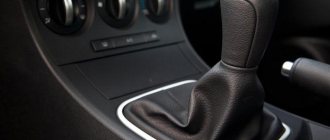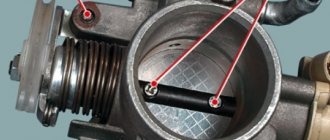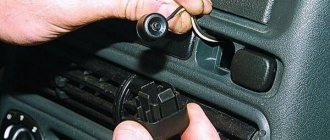The problem of shifting gears while the engine is running is common, especially in cars with a manual transmission. The malfunction can occur either completely unexpectedly, or gradually, making itself known by the appearance of a characteristic grinding sound and difficulties when shifting gears. In any case, without eliminating the cause of the malfunction, you will not be able to operate the car.
Gears engage with effort: gearbox malfunctions
In cars with a manual transmission, gear shifting is done by the driver himself. Using a lever from the interior, it acts on the rocker and then on the entire gearbox mechanism. Simply put, the driver moves the gears on the shafts.
Since the shafts rotate at high speeds, cooling is required. This is done using special gear oil. Oil also protects the surfaces of rubbing parts from premature wear. The lubricant must be changed on time. On average, this is done after every 40-50 thousand kilometers.
As for the reasons for tight gear engagement, there may be several of them. However, most often they are associated with problems in the clutch or the gearbox itself. If you study the list of the most common breakdowns, then you can highlight the following:
The exception is reverse gear, since it does not have synchronizers; By the way, when the reverse gear is difficult to engage, extraneous noises, clanging, and crunching often occur. Such phenomena directly indicate wear of the gear teeth.
Video “Repair of the gear shift unit in a VAZ car”
This video shows the process of repairing a gearbox in a VAZ car. The instructions are general and suitable for Kalina cars.
As you already understand, we will talk specifically about a manual “box” and about shifting gears (or rather, not shifting) on it. I have quite a lot of experience in this area; I personally repaired cars such as VAZ 2114, VAZ 2110 (and the 10th family in general). To say that there are global differences between foreign cars, there really aren’t any! So if your speed is not cut off, then the reasons may be similar. In general, the article will be useful, at the end, as usual, there is a video...
THE CONTENT OF THE ARTICLE
A fairly large number of such questions come to me, especially from novice drivers of our VAZs! Especially with front-wheel drive, because in rear-wheel drive cars the lever was installed in the manual transmission itself. I want to answer everyone right away - the problem of non-inclusion may not always be cardinal! Often it’s a small matter, something just got loose or unscrewed from time to time, as a rule, this happens in 50% of cases.
Therefore, I will try to break the material into two large components - simple and complex faults.
I suggest starting with simple faults.
What's the result?
So, the main reasons why gears are difficult to engage are problems with the clutch mechanism and gearbox. However, most of them can be eliminated yourself if you have tools, spare parts and certain skills.
Why may it be difficult to engage gears or why first gear, second, reverse, etc. may not engage? The main causes of gearbox malfunctions, recommendations.
Reasons for difficulty shifting gears with the engine running. Transmission oil and level in the gearbox, wear of synchronizers and gearbox gears, clutch.
How to change gears without a clutch: driving a manual car without a clutch in case of malfunction. Tips and tricks.
Manual transmission gears (speeds) do not engage after replacing the clutch: main reasons, settings and adjustments. Diagnosis of problems, useful tips.
Clutch: basket, release, clutch disc. Purpose and design, principle of operation of the clutch basket. How to increase clutch life.
The automatic transmission does not change gears: the car does not move forward or backward, the automatic transmission does not switch to individual gears, reasons.
Source
Engine mounts
I personally have never had this happen, but many people write that this is a fairly common problem. Actually, the problem is this: the engine hangs on cushions, the gearbox is connected to it (manual transmissions, by the way, have their own cushions). It happens that the fastening breaks, or it unscrews. The engine or “box” may sag, the scenes may break, or they will hit something.
THEN there is another not very serious problem - these are pillows! If the programs don’t turn on, then we watch them.
These malfunctions, AS I THINK, ARE NOT PROBLEMS AT ALL! Anyone can identify them on pits or lifts, and this is done quite quickly. Personally, I came across rockers and cables, using the example of a VAZ, a clutch cable.
However, if you have checked everything, and the gears do not engage with the engine running. Then it’s worth looking at the box itself and the accompanying attachments. Let's move on to complex faults.
Why is it difficult to engage gears?
The problem of shifting gears while the engine is running is common, especially in cars with a manual transmission. The malfunction can occur either completely unexpectedly, or gradually, making itself known by the appearance of a characteristic grinding sound and difficulties when shifting gears. In any case, without eliminating the cause of the malfunction, you will not be able to operate the car.
For what reasons do interruptions occur?
There can be many reasons why gears do not shift when the engine is running. However, all of them, in one way or another, are connected with the two most important units of the car - the engine or gearbox. In case of serious damage, you should contact a good car service.
If the problem is in the gearbox, it will need to be removed for further disassembly and troubleshooting. If the problem is with engine components, they may need to be replaced. However, there are cases when, to eliminate a malfunction, it is enough to carry out preventive maintenance: removal, lubrication and careful adjustment of the components.
For those with automatic
If your car has an automatic transmission. It will not hurt you to know the modes in which your machine can operate:
- P – For parking and starting the engine. Switching to this mode is possible only after the machine has completely stopped.
- R – To move backwards. Switching to this mode is also possible only after stopping the car and with the brake pedal pressed.
- N – Neutral. When the engine is completely disconnected from the gearbox.
- D – Moving forward without restrictions on gear shifting (the most commonly used operating mode of the automatic transmission).
- D3(S) – Low gears for climbing and braking engines on descents.
- D2 – Mode for difficult conditions (slippery or mountainous roads). Gears above second are not shifted, that is, only first and second gears are engaged.
- D1(L) - Movement occurs only in 1st gear, used off-road on mud, snow or ice, where you need to drive without changing the throttle, and also to overcome steep climbs.
The automatic transmission also has a button on the mode shift lever with the inscription O/D OFF. When it is turned on, the inclusion is prohibited, increasing the gears of the analogue of the 5th gear of the manual transmission. That is, if your automatic machine has 4 gears for moving forward, then for more dynamic acceleration it will use only three lower gears.
About a faulty automatic transmission, an automatic transmission is much more complex than those encountered with a manual transmission, and the chances of repairing it in your garage are slim. But despite this, you still need to know something about it, if only in order not to harm it through improper use.
An automatic transmission is much more demanding in terms of accuracy in maintaining the oil level in it than a manual transmission. Both too low and too high oil levels are very harmful to her. Both of these can lead to serious damage. In both cases, oil foaming occurs. When there is a lack of oil due to the fact that the oil pump begins to capture air along with the oil. When there is excess oil, it foams on the rotating parts, which in this case are immersed in it. Foamed oil compresses better and has low thermal conductivity. Therefore, if you operate a machine with such oil, the pressure in its control systems will be low. Which will lead to slipping of the clutches and their intensive wear. Deteriorated thermal conductivity will not allow all excess heat to be removed. Which, together with low pressure, will lead to the machine failing and requiring serious repairs.
Troubleshooting methods
Once the source of the problem has been found, you can begin to eliminate the causes of the malfunction.
If the problem is in the engine
The simplest cause of problems when shifting gears can be a leak of brake fluid, which is the working fluid for the clutch. If there is insufficient lubrication in the clutch hydraulic system, it will not engage fully. Therefore, first check the fluid level in the car's tank. If the level is low, check for leaks, repair defects and bleed the clutch. When the fluid level is at the normal level, the clutch elements should be inspected.
Clutch problems
The clutch consists of three main components:
Malfunctions of these units can lead to problems with gear shifting when the engine is running.
The fact that the bearing is failing may be indicated by the appearance of a rustling or distinct hum when the engine is running and the clutch pedal is pressed to the floor. When you release the pedal, the noise should stop. When the bearing completely jams, it will no longer be possible to operate the gear shift mechanism. In this case, the unit will need to be replaced.
A faulty basket can also cause the problem. This often results from critical wear of the petals. In this case, the basket stops performing its functions when heated, and it is not possible to completely remove the pressure disk. Therefore, after removing the box, it is necessary to carefully inspect the basket for deformations and other defects. If the condition of the unit is not satisfactory, it should be replaced with a new one.
Finally, the last reason for problematic gear shifting associated with the clutch is wear or deformation of the disc and the friction linings on it.
Important! After the failed elements are replaced, during assembly the box should be centered and the clutch should be pumped.
The problem is at the checkpoint
The most common cause of a gearbox malfunction is wear of the synchronizers. You may have previously been warned about this by a characteristic crunch when changing gears. Synchronizers that smooth out the angular speeds of the shafts are usually made of copper and are therefore subject to wear.
Much less often, the gearbox shafts themselves can fail. In this case, a separate transmission may not be included. The degree of wear and the need for replacement is also determined after dismantling and disassembling the transmission.
Important! To eliminate faults that have arisen in the box, a major overhaul may be required, which is not cheap and does not happen quickly. Therefore, you need to be prepared for the fact that your car will be delayed in service.
However, you should not immediately think about the bad. Sometimes a problem with gear shifting can be caused by a lack of oil in the gearbox. Loud noise while driving or a metallic grinding sound in the box may indicate insufficient oil level. If there is a complete lack of oil, you will not be able to change gears at all: the synchronizers will not function properly. Changing the gearbox oil is recommended every 60-80 kilometers.
In addition to checking the oil level in the gearbox, you will also need to inspect the unit body for damage and the absence of lubricant leaks through the gaskets and seals.
Removal and installation of gearbox Lada Kalina 1117 2004 - 2021
Tools:
Parts and consumables:
Note:
We carry out the work with an assistant on an inspection ditch or overpass.
1. Drain the oil from the gearbox as described here. Disconnect the wire terminal from the negative terminal of the battery. Remove the air filter as described here. Remove the starter as described here. We remove the clutch cable lead from the groove of the clutch release fork lever, following the instructions described here.
2. Disconnect the wiring block from the reverse light switch.
3. Disconnect the wire block from the speed sensor.
4. Using a 10mm wrench, unscrew the three bolts securing the lower clutch housing cover.
5. Remove the clutch housing cover.
6. Remove the right and left front wheel drives, as described here. Using a 13mm spanner, loosen the tightening of the nut of the coupling bolt of the clamp securing the control rod to the shank of the gear selector rod hinge. Then disconnect the transmission control rod.
7. Using a 19mm wrench, unscrew the nuts of the two bolts securing the clutch housing to the gearbox housing (which also secure the torque rod bracket), holding the bolts from turning with a head of the same size.
8. We remove the reaction rod with the bracket from the gearbox.
9. Disconnect the plastic throttle cable holder from the gearbox bracket.
10. Using a 13mm socket, unscrew the bolt securing the ignition coil bracket to the clutch housing.
11. Using a 19mm socket, unscrew the two upper bolts securing the gearbox to the cylinder block, which simultaneously secure the bracket with the holders of the throttle cable and wiring harness. The front bolt (in the direction of vehicle travel) is shorter than the rear bolt. We remove the bracket with the cable and wiring harness from the gearbox.
12. Remove the left front suspension brace as described here. We install adjustable stops through wooden blocks under the engine oil pan and gearbox housing.
13. Using a 19mm spanner, unscrew the nut of the lower rear mounting of the gearbox to the cylinder block.
14. Using a 19mm socket, unscrew the bolt of the lower front fastening of the gearbox to the cylinder block.
15. Using the “E-14” head, unscrew the two screws securing the front left support bracket of the power unit to the support.
16. Using a 15mm socket, unscrew the three nuts securing the bracket for the front left support of the power unit to the gearbox.
17. Remove the bracket.
18. Using a 19mm socket, unscrew the two outer bolts 1 securing the rear support bracket of the power unit to the gearbox, and using a 17mm socket, unscrew the middle bolt 2.
19. We move the gearbox away from the engine, removing the input shaft from the hub of the driven clutch disc.
20. When removing and installing the gearbox, do not rest the gearbox input shaft on the clutch diaphragm spring petals so as not to damage them. Before installing the gearbox, apply a thin layer of CV joint-4 lubricant to the splined end of the input shaft.
New Lada: What kind of oil to fill in the box of Lada Kalina - Auto repair
21. We insert the input shaft of the gearbox into the splines of the driven clutch disk and, orienting the gearbox so that the two guide pins fit into the corresponding holes in the clutch housing, and the standard pin of the clutch housing into the hole in the cylinder block, push the gearbox all the way into the engine cylinder block .
22. Fill the gearbox with oil as described here.
The article is missing:
Gears are difficult to engage: causes, solutions
With the car running, first gear became difficult to engage. Reverse gear engages with a crunch, as if the clutch is not fully depressed. If you apply the gas several times, first or reverse gears are engaged. Starting today I start in second gear. When the car is turned off, all gears shift normally and easily. Today I stopped by Shabashkin’s office, they announced: Replacement of the clutch kit – 4,000 rubles + 6,000-10,000 rubles. the cost of this kit. Expensive. Tomorrow I want to go to another, expensive service, I’ll listen to what they say. What thoughts does anyone have? PS I would like to know the part numbers for the clutch kit for my car, can anyone help me with this? In our area the prices are sky-high, I want to order from Exist.
Just arrived from the service. The masters said: if the rear speed crunches, change the clutch 100%. The price was announced on the street as 2000 rubles, when they took it up on the lift, the price increased to 2400 rubles, I don’t know why. Then they told me to go home and film for three hours. They called for lunch, come. I saw the disassembled clutch assembly and said to replace it in its entirety. The box was removed for the first time (the words of the master). After 13 years of operation, this is not a bad result. Ferrido was eaten down to the rivets, the rivets began to shuffle along the basket disk. All the tabs on the basket were intact, but the basket disk had circular purple stripes, which indicated that the clutch was not pressed or was slipping. There was no “pocket” on which the rod rests, it was torn off, along with the rivet. The old rod was shorter than the new one I brought by 2 mm. When replacing the support bearing, half a liter of oil spilled out! One day they found two places where antifreeze was leaking. From under the thermostat cover (I bought a new one) and from the pipe that goes to the recently installed gas equipment reducer. As luck would have it, I forgot my camera and cell phone at home today, no photos. I hope to take pictures of everything tomorrow for the report, but perhaps by then the box will have already been delivered.
About costs: SACHS clutch kit – 6,000 rubles. + support+rod+stage seal – 1000 RUR. Thermostat cover – 200 rub. Oil for box 1l. – 500 rub. Clutch replacement work – RUB 2,400. The work of replacing the thermostat cover and the rocker seal - 500 rubles (I bargained for 200 rubles).
And that: 10,600 rubles.
The number of my oil is this: VAG G 060 726 A2 They will add half a liter of this to me: Castrol 4008177071775 Syntrax Universal Plus They have the same API specifications GL-4
The reason was a broken penny, which is not in photos 1,2 and the old rod (pusher) was 2 mm shorter than the new one, which is why the clutch was underloaded by 4-5 mm. The basket was in normal condition, only it had purple circular rings, which indicated that it was overheating. Ferrido was already “fit”, the opening was on time, on one side it was worn down to the rivets. The condition of the support bearing is normal, I changed it a bunch.
The gearbox is a complex mechanism that requires constant maintenance. Including regular diagnostics and oil changes. Ignoring these measures often leads to problems with gear shifting.











